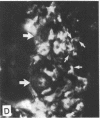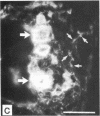Abstract
During development of delayed hypersensitivity (DH) skin reactions, fibronectin accumulates in two distinct sites: (a) the dermal interstitium in a pattern similar to fibrin and with a time course similar to that of fibrin deposition and mononuclear cell infiltration, and (b) blood vessel walls in a pattern suggestive of basement membrane staining and with a time course similar to that of endothelial cell proliferation. In vitro fibronectin can bind to monocytes or endothelial cells and simultaneously bind to fibrin or collagen matrices; by such interaction in vivo it may affect cell migration or proliferation. Thus, fibronectin deposition in DH reactions may facilitate cell-matrix interactions; however, the possibility exists that extravascular fibronectin accumulation may be only secondary to interstitial fibrin clot formation, and that blood vessel-associated fibronectin may be only a function of adsorption onto basement membrane (type IV) collagen. To address these possibilities, we investigated the association of fibronectin with fibrin, type IV collagen, and mononuclear cell infiltrates in DH reactions. Skin sites of DH reactions in normal volunteers were biopsied at 24, 48, and 72 h after intradermal challenge and examined by immunofluorescence technique. At all time points most of the interstitial fibronectin coincided with fibrin; however, some interstitial fibronectin was coincident with mononuclear cells positive for HLA-DR or monocyte-specific antigen. The coincidence of fibronectin with mononuclear cells was more apparent in a 48-h DH reaction from a patient with congenital afibrinogenemia. Vessel wall fibronectin was increased by 48 h after challenge and appeared as a fine linear band on the luminal side of a much thicker band of type IV collagen. Thus, the coincidence of extravascular fibronectin with mononuclear cells, its appearance without fibrin in the site from a patient with afibrinogenemia, and incomplete correspondence of vessel wall fibronectin with type IV collagen suggest that fibronectin localization in DH reactions involves endothelial cell and mononuclear cell binding as well as adsorption to fibrin and/or type IV collagen.
Full text
PDF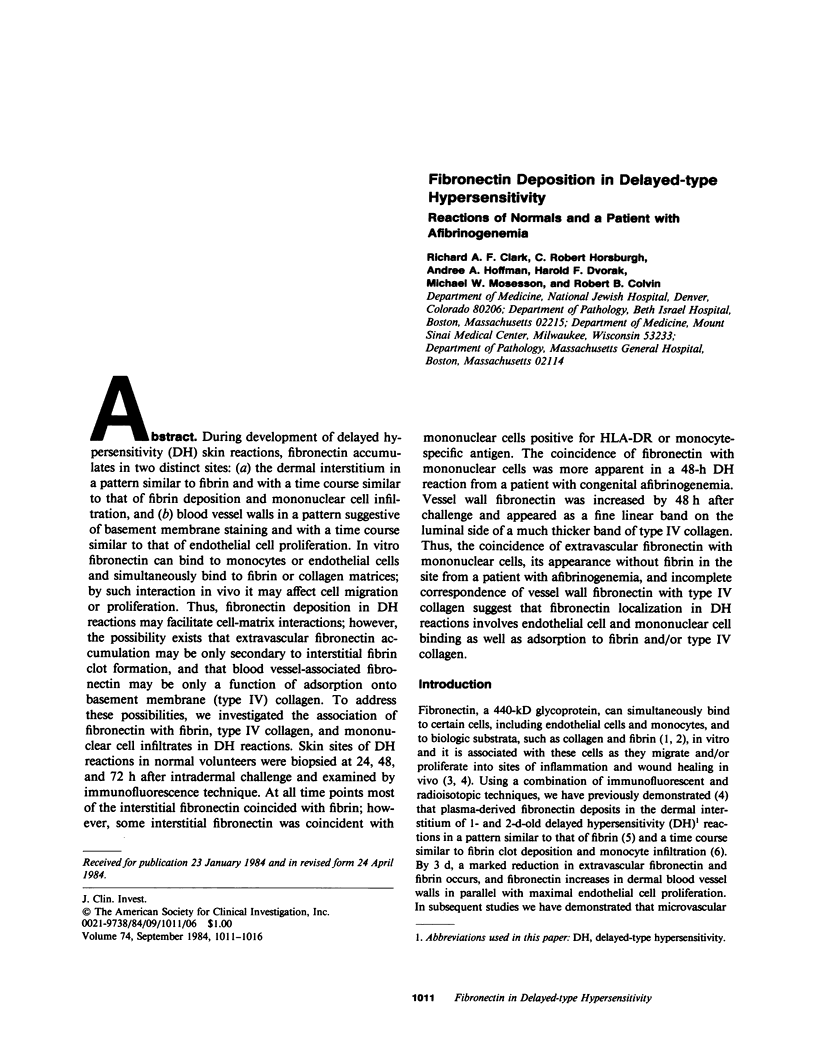
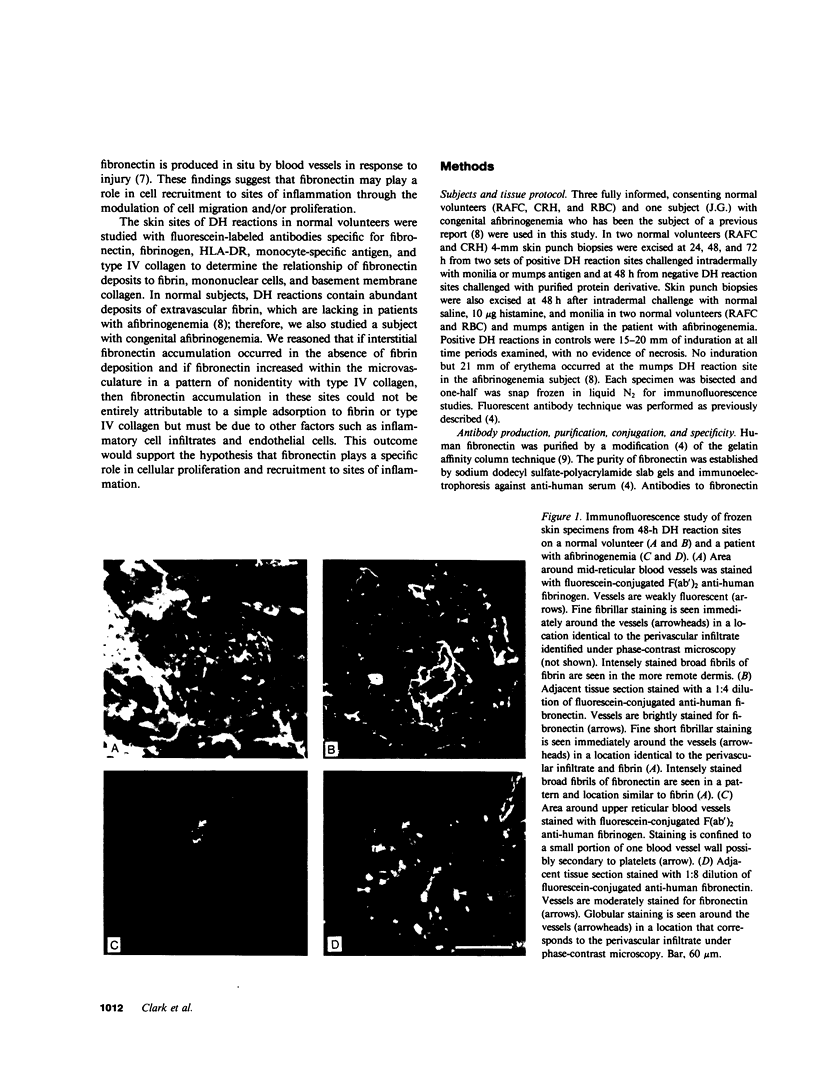
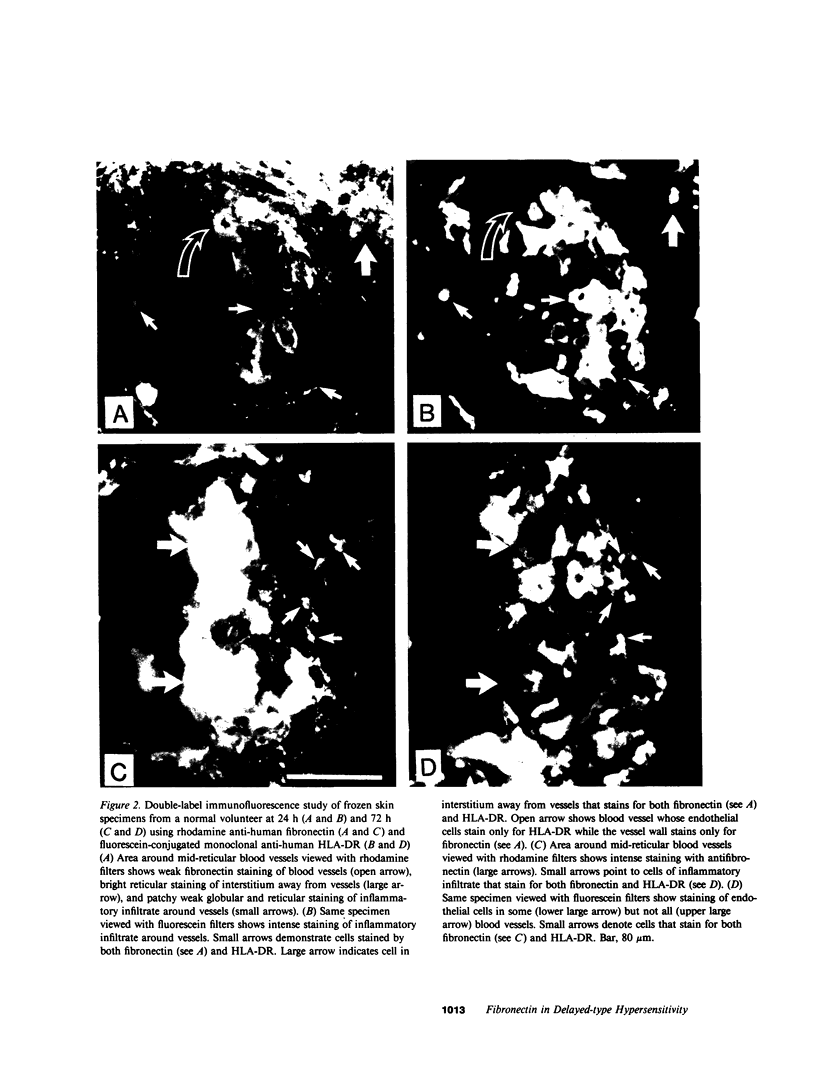
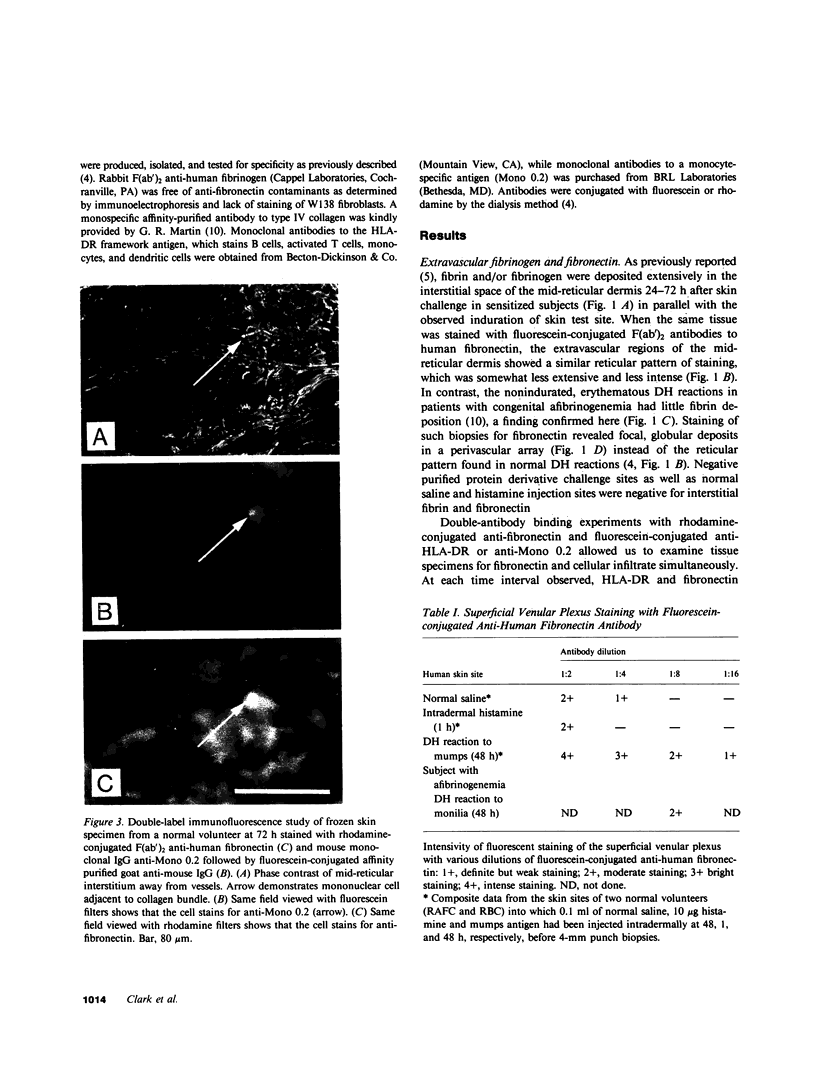
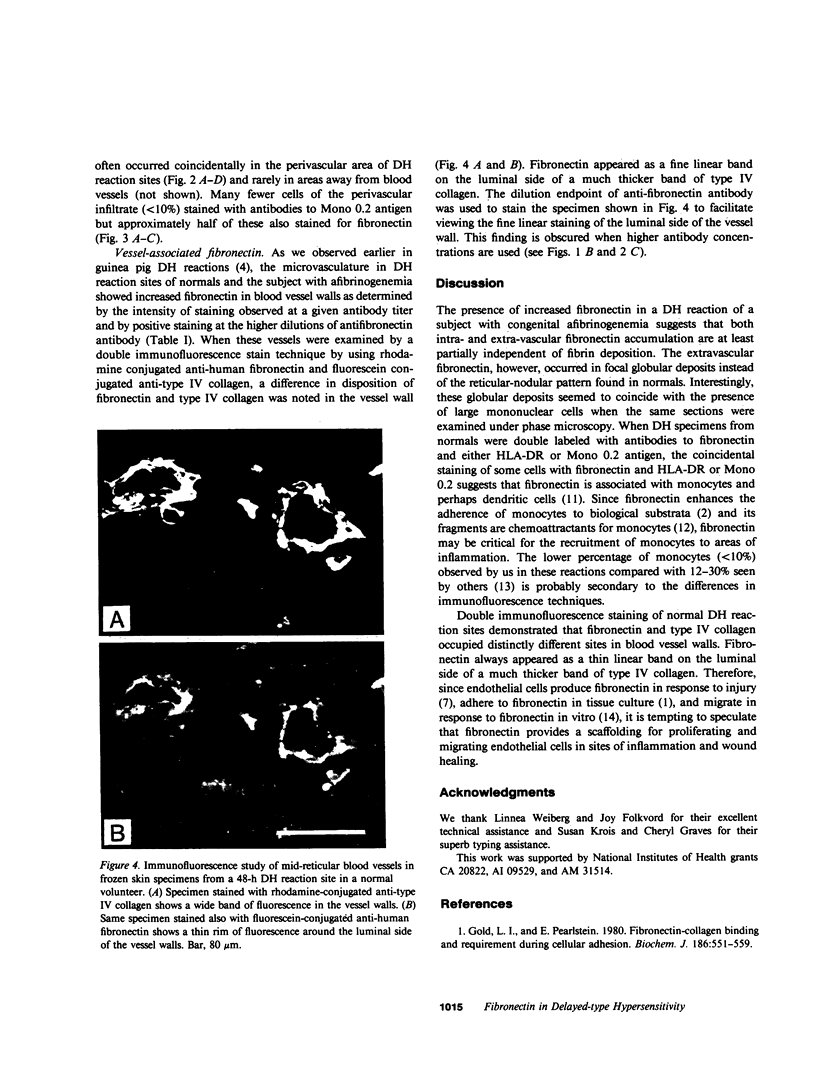
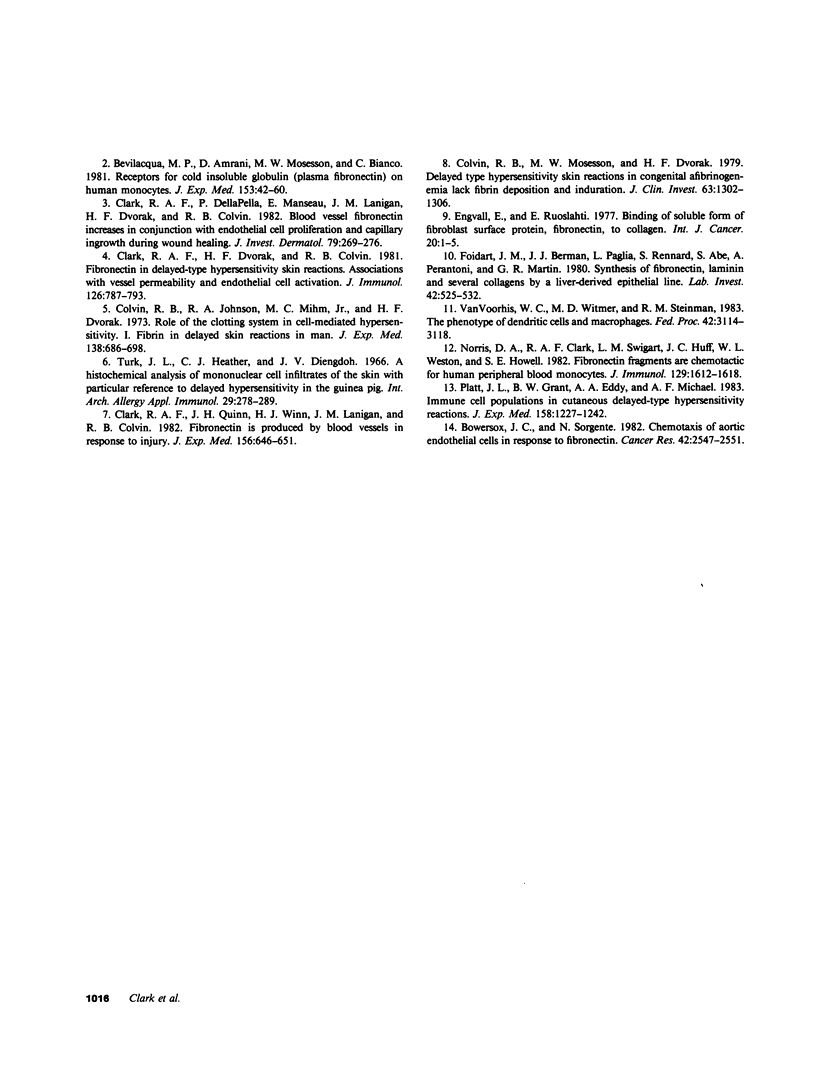
Images in this article
Selected References
These references are in PubMed. This may not be the complete list of references from this article.
- Bevilacqua M. P., Amrani D., Mosesson M. W., Bianco C. Receptors for cold-insoluble globulin (plasma fibronectin) on human monocytes. J Exp Med. 1981 Jan 1;153(1):42–60. doi: 10.1084/jem.153.1.42. [DOI] [PMC free article] [PubMed] [Google Scholar]
- Bowersox J. C., Sorgente N. Chemotaxis of aortic endothelial cells in response to fibronectin. Cancer Res. 1982 Jul;42(7):2547–2551. [PubMed] [Google Scholar]
- Clark R. A., DellaPelle P., Manseau E., Lanigan J. M., Dvorak H. F., Colvin R. B. Blood vessel fibronectin increases in conjunction with endothelial cell proliferation and capillary ingrowth during wound healing. J Invest Dermatol. 1982 Nov;79(5):269–276. doi: 10.1111/1523-1747.ep12500076. [DOI] [PubMed] [Google Scholar]
- Clark R. A., Dvorak H. F., Colvin R. B. Fibronectin in delayed-type hypersensitivity skin reactions: associations with vessel permeability and endothelial cell activation. J Immunol. 1981 Feb;126(2):787–793. [PubMed] [Google Scholar]
- Clark R. A., Quinn J. H., Winn H. J., Lanigan J. M., Dellepella P., Colvin R. B. Fibronectin is produced by blood vessels in response to injury. J Exp Med. 1982 Aug 1;156(2):646–651. doi: 10.1084/jem.156.2.646. [DOI] [PMC free article] [PubMed] [Google Scholar]
- Colvin R. B., Johnson R. A., Mihm M. C., Jr, Dvorak H. F. Role of the clotting system in cell-mediated hypersensitivity. I. Fibrin deposition in delayed skin reactions in man. J Exp Med. 1973 Sep 1;138(3):686–698. doi: 10.1084/jem.138.3.686. [DOI] [PMC free article] [PubMed] [Google Scholar]
- Colvin R. B., Mosesson M. W., Dvorak H. F. Delayed-type hypersensitivity skin reactions in congenital afibrinogenemia lack fibrin deposition and induration. J Clin Invest. 1979 Jun;63(6):1302–1306. doi: 10.1172/JCI109425. [DOI] [PMC free article] [PubMed] [Google Scholar]
- Engvall E., Ruoslahti E. Binding of soluble form of fibroblast surface protein, fibronectin, to collagen. Int J Cancer. 1977 Jul 15;20(1):1–5. doi: 10.1002/ijc.2910200102. [DOI] [PubMed] [Google Scholar]
- Foidart J. M., Berman J. J., Paglia L., Rennard S., Abe S., Perantoni A., Martin G. R. Synthesis of fibronectin, laminin, and several collagens by a liver-derived epithelial line. Lab Invest. 1980 May;42(5):525–532. [PubMed] [Google Scholar]
- Gold L. I., Pearlstein E. Fibronectin-collagen binding and requirement during cellular adhesion. Biochem J. 1980 Feb 15;186(2):551–559. doi: 10.1042/bj1860551. [DOI] [PMC free article] [PubMed] [Google Scholar]
- Norris D. A., Clark R. A., Swigart L. M., Huff J. C., Weston W. L., Howell S. E. Fibronectin fragment(s) are chemotactic for human peripheral blood monocytes. J Immunol. 1982 Oct;129(4):1612–1618. [PubMed] [Google Scholar]
- Platt J. L., Grant B. W., Eddy A. A., Michael A. F. Immune cell populations in cutaneous delayed-type hypersensitivity. J Exp Med. 1983 Oct 1;158(4):1227–1242. doi: 10.1084/jem.158.4.1227. [DOI] [PMC free article] [PubMed] [Google Scholar]
- Van Voorhis W. C., Witmer M. D., Steinman R. M. The phenotype of dendritic cells and macrophages. Fed Proc. 1983 Nov;42(14):3114–3118. [PubMed] [Google Scholar]









